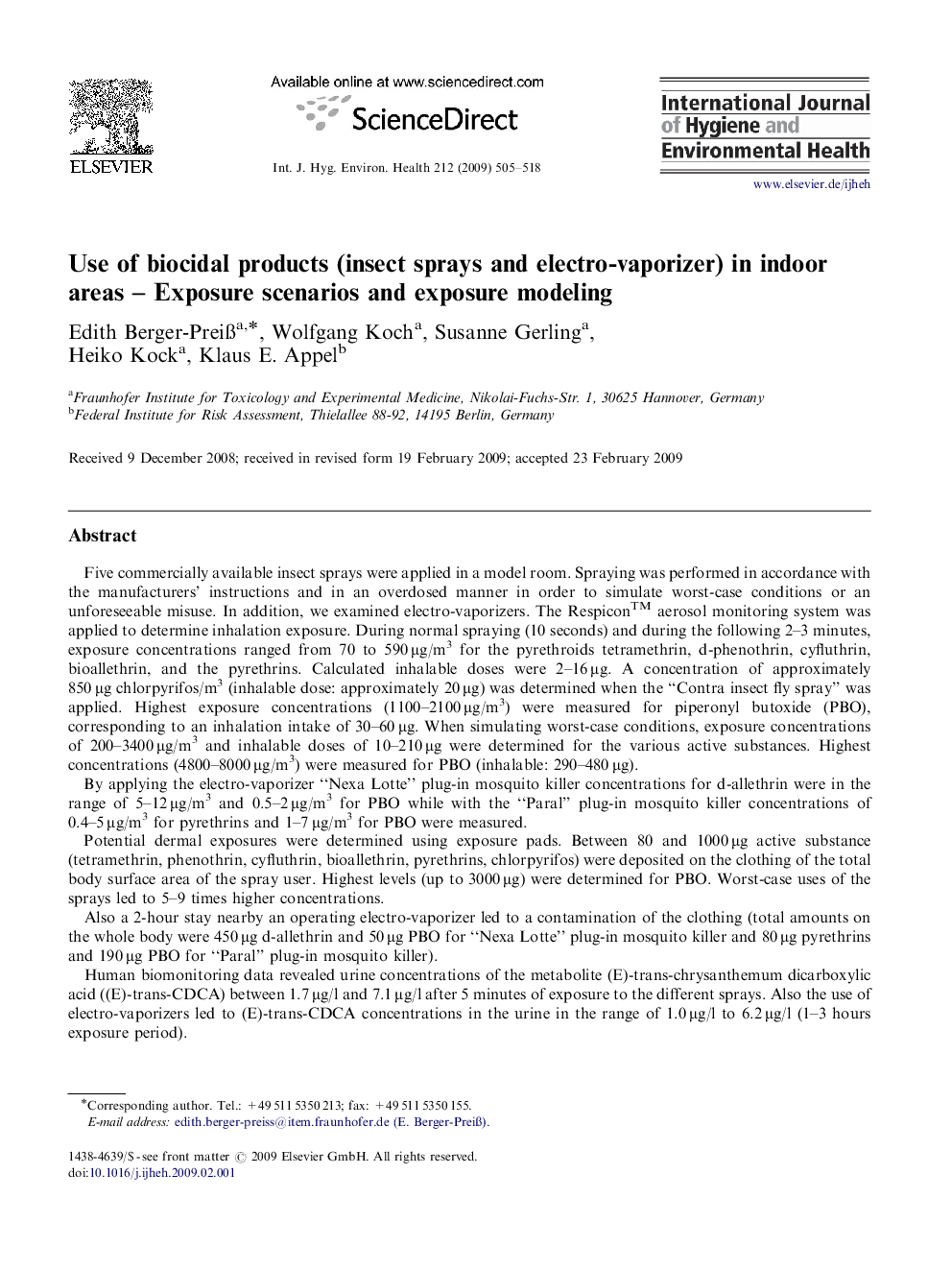| کد مقاله | کد نشریه | سال انتشار | مقاله انگلیسی | نسخه تمام متن |
|---|---|---|---|---|
| 2589035 | 1561925 | 2009 | 14 صفحه PDF | دانلود رایگان |

Five commercially available insect sprays were applied in a model room. Spraying was performed in accordance with the manufacturers’ instructions and in an overdosed manner in order to simulate worst-case conditions or an unforeseeable misuse. In addition, we examined electro-vaporizers. The Respicon™ aerosol monitoring system was applied to determine inhalation exposure. During normal spraying (10 seconds) and during the following 2–3 minutes, exposure concentrations ranged from 70 to 590 μg/m3 for the pyrethroids tetramethrin, d-phenothrin, cyfluthrin, bioallethrin, and the pyrethrins. Calculated inhalable doses were 2–16 μg. A concentration of approximately 850 μg chlorpyrifos/m3 (inhalable dose: approximately 20 μg) was determined when the “Contra insect fly spray” was applied. Highest exposure concentrations (1100–2100 μg/m3) were measured for piperonyl butoxide (PBO), corresponding to an inhalation intake of 30–60 μg. When simulating worst-case conditions, exposure concentrations of 200–3400 μg/m3 and inhalable doses of 10–210 μg were determined for the various active substances. Highest concentrations (4800–8000 μg/m3) were measured for PBO (inhalable: 290–480 μg).By applying the electro-vaporizer “Nexa Lotte” plug-in mosquito killer concentrations for d-allethrin were in the range of 5–12 μg/m3 and 0.5–2 μg/m3 for PBO while with the “Paral” plug-in mosquito killer concentrations of 0.4–5 μg/m3 for pyrethrins and 1–7 μg/m3 for PBO were measured.Potential dermal exposures were determined using exposure pads. Between 80 and 1000 μg active substance (tetramethrin, phenothrin, cyfluthrin, bioallethrin, pyrethrins, chlorpyrifos) were deposited on the clothing of the total body surface area of the spray user. Highest levels (up to 3000 μg) were determined for PBO. Worst-case uses of the sprays led to 5–9 times higher concentrations.Also a 2-hour stay nearby an operating electro-vaporizer led to a contamination of the clothing (total amounts on the whole body were 450 μg d-allethrin and 50 μg PBO for “Nexa Lotte” plug-in mosquito killer and 80 μg pyrethrins and 190 μg PBO for “Paral” plug-in mosquito killer).Human biomonitoring data revealed urine concentrations of the metabolite (E)-trans-chrysanthemum dicarboxylic acid ((E)-trans-CDCA) between 1.7 μg/l and 7.1 μg/l after 5 minutes of exposure to the different sprays. Also the use of electro-vaporizers led to (E)-trans-CDCA concentrations in the urine in the range of 1.0 μg/l to 6.2 μg/l (1–3 hours exposure period).The exposure data presented can be used for performing human risk assessment when these biocidal products were applied indoors.The airborne concentrations of the non-volatile active chemical compounds could be predicted from first principles using a deterministic exposure model (SprayExpo).
Journal: International Journal of Hygiene and Environmental Health - Volume 212, Issue 5, September 2009, Pages 505–518